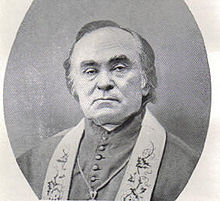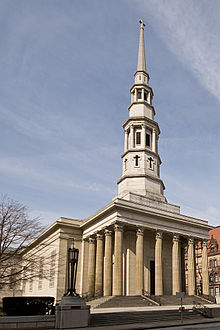- Cincinnati riot of 1853
-
 Daguerreotype of Cardinal Bedini to USA in 1853 (National Portrait Gallery, Smithsonian Institution, USA).
Daguerreotype of Cardinal Bedini to USA in 1853 (National Portrait Gallery, Smithsonian Institution, USA).
The Cincinnati Riot of 1853 was triggered by the visit of Cardinal Gaetano Bedini, the emissary of Pope Pius IX, to Cincinnati, Ohio, USA on 21 December 1853. The German Liberal population of the city, many of whom had come to America after the Revolutions of 1848, identified Cardinal Bedini with their "reactionary" opponents.[1] An armed mob of about 500 German men with 100 women following marched on the home of Bishop John Purcell, protesting the visit. One protester was killed and more than 60 were arrested.[2]
Contents
Build-up
Bedini was sent to America to deal with a number of disputes over church property. The central argument was over whether ownership of a church and its land should remain with the board of trustees appointed by the congregation, or should be transferred to the bishop as representative of the church. The issue was controversial, since many Protestants and Liberals thought that the "Church of Rome" had no right to own property in the United States. Unfortunately, Bedini not only lacked tact and experience in diplomacy, but he was already despised by many Americans for his role in overthrowing the Anti-Papal Roman Republic in 1849.[3]
 John Baptist Purcell, Archbishop of Cincinnati
John Baptist Purcell, Archbishop of Cincinnati
At the time of the Cardinal's visit, anti-Catholic feelings were strong in Cincinnati. Archbishop John Purcell had alienated many people by objecting to taxing Catholics for support of public schools.[4] Hearing of Bedini's visit, the Daily Commercial printed a very unfavorable article, and the Freemen's Hochwächter started printing scurrilous articles calling him the "Butcher of Bologna". The Nativist Know-Nothing groups singled Bedini out as a target for attack. The German "Forty Eighters" of Cincinnati were in full support of the Nativists at this time.[1] However, the Germans were not a unified group. The Dreissiger (Thirtiers), who had left Germany in the 1830s to escape political repression, were against activism and the German Catholics defended their religion.[5]
On the day of Bedini's arrival, the Hochwächter published an article that began: "Reader, dost thou know who Bedini is? Lo! there is blood on his hands - human blood! Lo! the skin will not leave his hands which at his command was flayed from Ugo Bassi! Lo! a murderer, a butcher of men..." The article went on to essentially demand the Cardinal's assassination, appealing specifically to the Freimänner (Society of Freemen), about 1,200 men with a meeting house in the Over-the-Rhine section of the city.[1]
The march
On Christmas Day, Bedini preached in French and German at the Saint Peter in Chains Cathedral.[6] Meanwhile, the Freimänner called for a meeting in the morning to prepare for a demonstration, inviting other groups, and spent the afternoon making effigies, banners and placards.
The Mayor was informed what was afoot and ordered the Chief of Police, Captain Thomas Lukens, to investigate. Certain that there would be no trouble on Christmas Day, the mayor then went home to his family. Soon after, Captain Lukens heard that the march had started. He ordered 100 policemen to a post opposite the Bishop's Chancery beside the cathedral.[1]
The march began soon after 10 p.m., with over 500 men led by a drum section, and followed by 100 women. In addition to banners and placards, several of the men carried a wooden scaffold from which was hanging an effigy of the Cardinal.
When the police advanced to meet the demonstrators, one of the marchers fired a shot. The police charged and a general brawl ensued in which two policemen and fifteen German demonstrators were wounded, one fatally. Over 60 demonstrators were arrested.[1]
Aftermath
The legal proceedings that followed were strongly biased in favor of the Germans. After the police had testified, the prosecuting attorney said no proof had been given that there was intent to do violence to Cardinal Bedini. The court then dismissed the indictment on the basis that the case had been abandoned by the prosecution. The publisher of the Hochwachter was arrested, but later discharged when no proof was found of a conspiracy to murder the Nuncio. A meeting was called to protest the arrests and demand that the mayor resign. Although the mayor kept his job, the Chief of Police was dismissed.[1]
Feelings ran so high in the later part of Bedini's visit that in New York he had to be smuggled into the ship for his return voyage.[7]
Although Cincinnati's Nativists had supported the German demonstrators, the incident continued to feed controversy over foreign immigration to America. Ultimately, the riot directly contributed to the rise of the anti-immigrant and anti-Catholic Know-Nothing Party and to conflicts with recent immigrants.[8]
Two years later, in the Cincinnati riots of 1855, a mob of Know-Nothing supporters carried out a pogrom of the German immigrants in Over-the-Rhine.[9]
References
- ^ a b c d e f James F. Connelly (1960). The visit of Archbishop Gaetano Bedini to the United States of America: June 1853-February 1854. Editrice Pontificia Università Gregoriana. p. 96ff. ISBN 8876520821. http://books.google.ca/books?id=tMujE27nNvcC&pg=PA96. Retrieved 2010-10-25.
- ^ Joseph M. White (2007). Worthy of the Gospel of Christ: A History of the Catholic Diocese of Fort Wayne-South Bend. Our Sunday Visitor Publishing. p. 72. ISBN 1592762298. http://books.google.ca/books?id=EGuVYySOT80C&pg=PT86. Retrieved 2010-10-25.
- ^ Tyler Anbinder (1994). Nativism and slavery: the northern Know Nothings and the politics of the 1850's. Oxford University Press US. p. 27. ISBN 0195089227. http://books.google.ca/books?id=lWlRyjY7EvwC&pg=PA27. Retrieved 2010-10-25.
- ^ Frederick J. Blue (1987). Salmon P. Chase: a life in politics. Kent State University Press. p. 97. ISBN 0873383400. http://books.google.ca/books?id=Wyxj7Y3Fh7AC&pg=PA97.
- ^ Andrew Robert Lee Cayton (2002). Ohio: the history of a people. Ohio State University Press. p. 145. ISBN 0814208991. http://books.google.ca/books?id=tC9d4JVvefIC&pg=PA145.
- ^ Roger Antonio Fortin (2002). Faith and action: a history of the Catholic Archdiocese of Cincinnati, 1821-1996. Ohio State University Press. p. 108. ISBN 0814209041. http://books.google.ca/books?id=T6WOJBt-xWcC&pg=PA108.
- ^ William E. Gienapp (1988). The Origins of the Republican Party, 1852-1856. Oxford University Press US. p. 94. ISBN 0195055012. http://books.google.ca/books?id=AWtZnsxMCDEC&pg=PA94. Retrieved 2010-10-25.
- ^ Margaret C. DePalma (2004). Dialogue on the frontier: Catholic and Protestant relations, 1793-1883. Kent State University Press. p. xiv. ISBN 0873388143. http://books.google.ca/books?id=4jPfbCh_qYUC&pg=PR14. Retrieved 2010-10-25.
- ^ John Kiesewetter (July 15, 2001). "Civil unrest woven into city's history". The Cincinnati Enquirer. http://www.enquirer.com/editions/2001/07/15/tem_civil_unrest_woven.html. Retrieved 2010-10-25.
Cincinnati riots 1829 Attack on blacks • 1836 Attack on abolitionist press • 1841 Attack on blacks • 1853 Papal envoy visit • 1855 Attack on Germans • 1884 Rigged jury dispute • 1967 Disputed murder conviction • 1968 Martin Luther King assassination • 2001 Police shooting of suspectCategories:- 1853 in Ohio
- Riots and civil disorder in the United States
- History of Cincinnati, Ohio
- Anti-Catholicism in the United States
- Anti-Catholic pogroms in the United States
- 1853 riots
Wikimedia Foundation. 2010.

